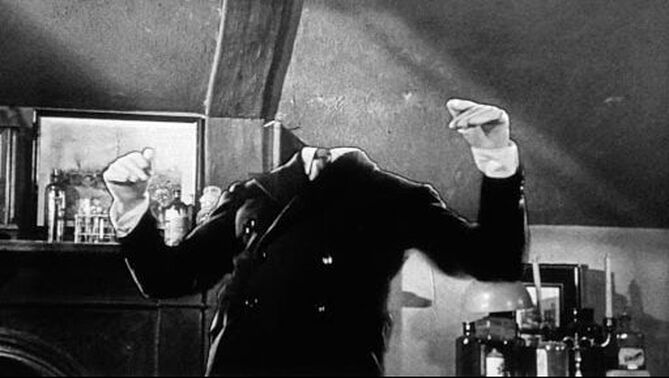
“The Invisible Man” (1933): A Cinematic Marvel of Science and Madness – Review

Amidst the pantheon of Universal Monsters that emerged in the early decades of cinema, “The Invisible Man” (1933) occupies a special place. Helmed by the legendary James Whale, the film distinguishes itself not only through its narrative innovations but also its pioneering technical achievements. In a sense, it’s a study of invisibility on multiple levels: the literal disappearance of its protagonist and the unseen, cutting-edge techniques that brought this story to life.
Narrative Allure: Man, Science, and Ambition:
Adapted from H.G. Wells’ 1897 novel, “The Invisible Man” chronicles the tragic journey of Dr. Jack Griffin, a scientist who discovers a formula that renders him invisible. However, an unforeseen side effect of the drug induces erratic and increasingly violent behavior. The story unfolds as Griffin’s initial euphoria over his groundbreaking discovery devolves into a descent into madness, as he becomes both metaphorically and literally detached from the world he once inhabited.
The film grapples with themes that were particularly pertinent during the early 20th century, an era defined by rapid scientific advancements and the ethical questions they posed. Griffin’s character embodies the perils of unchecked ambition, illustrating the potential dangers when man tries to play god without fully understanding or respecting the implications of his actions.
A Masterclass in Production and Effects:
“The Invisible Man” stands as a testament to the sheer inventiveness of early filmmakers. Given the limitations of the 1930s, achieving the effect of invisibility was a formidable challenge. Through a combination of innovative wirework, rotoscoping, and groundbreaking traveling matte techniques, the production team managed to create scenes that were nothing short of revolutionary for the time.
In sequences where Griffin unwraps his bandaged face to reveal nothingness beneath or when he removes his robe to showcase his transparent form, audiences of the day were witnessing cinematic magic. These scenes were achieved using black velvet suits against black backgrounds, a primitive version of what would later become the green screen technology. The process was tedious and demanded a high degree of precision, but the end result was worth the meticulous labor.
The genius of this production approach lies in its subtlety. While the film showcases its visual effects, it never allows them to overshadow the narrative or the performances. The invisibility becomes not just a gimmick but a central element of the story, adding layers of depth to Griffin’s increasingly fragmented psyche.
Performances and Direction: The Visible Strengths:
While the visual effects are certainly a standout, the film’s true strength lies in its performances, particularly Claude Rains in the titular role. Making his American film debut, Rains faced the unique challenge of conveying emotion and presence without being seen for most of the film. His voice becomes the primary tool of expression, oscillating between calm, reasoned tones and manic outbursts, painting a vivid picture of a mind in turmoil.
James Whale, fresh off his success with “Frankenstein,” showcased his directorial prowess by weaving a tale that combined horror, science fiction, and dark humor. His ability to balance the film’s more fantastical elements with genuine human drama showcases why he remains one of the most revered directors in the horror genre.
Legacy and Impact:
“The Invisible Man” has left an indelible mark on the landscape of horror and science fiction. Beyond its narrative strengths and performances, it’s remembered for pushing the boundaries of what was technically possible in cinema. Its innovative techniques paved the way for future generations of filmmakers to expand their visual storytelling horizons.
As we look back, it’s clear that the film’s themes are timeless. The moral quandaries associated with unchecked scientific progress, the isolation that can come with great personal discovery, and the fine line between genius and madness are all topics that resonate deeply even today.
In the grand tapestry of cinematic history, “The Invisible Man” emerges not just as an entertaining film but as a masterclass in storytelling, direction, and technical innovation. It serves as a reminder of cinema’s enduring power to captivate, challenge, and inspire.




